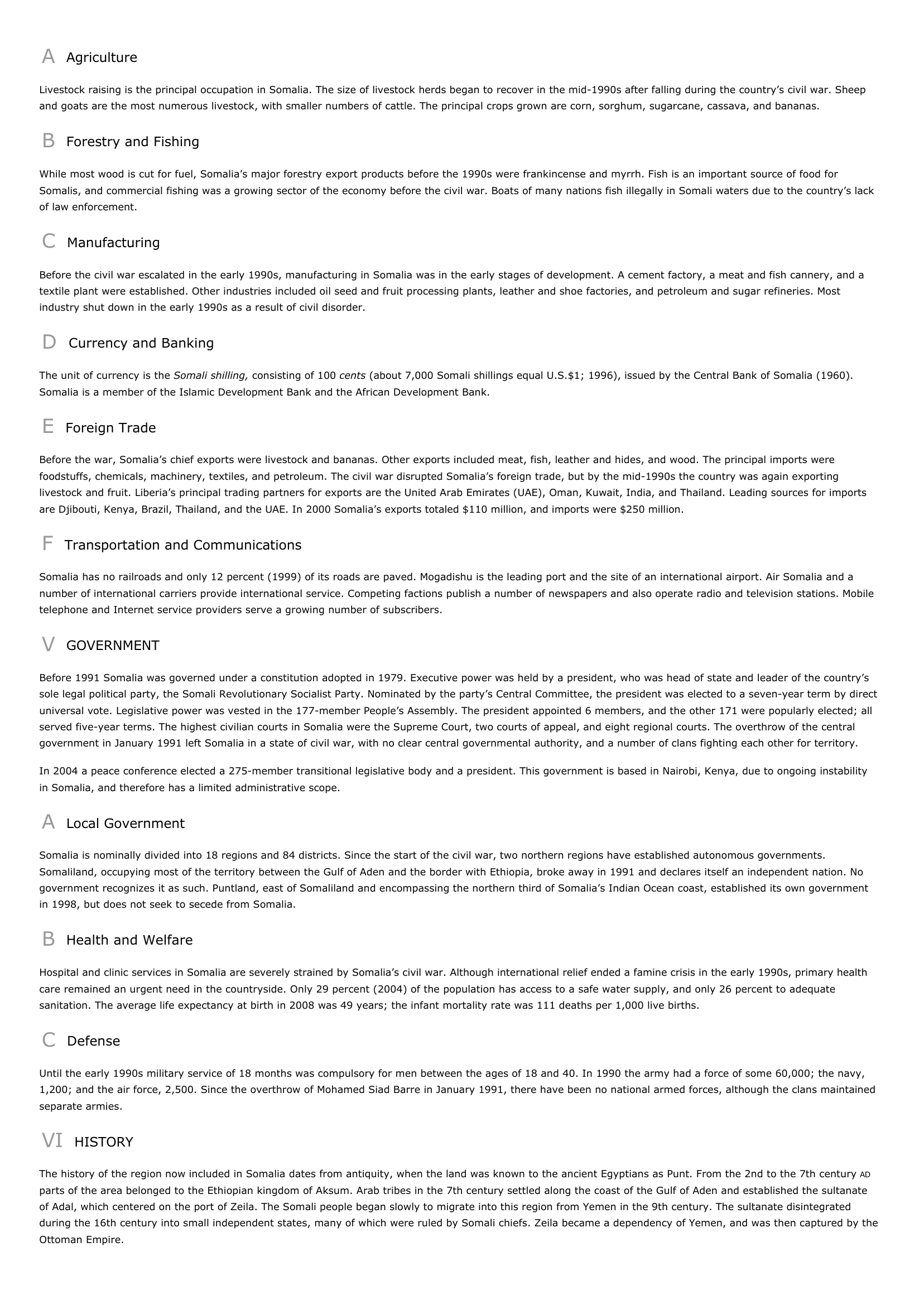Somalia - country.
Publié le 04/05/2013

Extrait du document
«
A Agriculture
Livestock raising is the principal occupation in Somalia.
The size of livestock herds began to recover in the mid-1990s after falling during the country’s civil war.
Sheepand goats are the most numerous livestock, with smaller numbers of cattle.
The principal crops grown are corn, sorghum, sugarcane, cassava, and bananas.
B Forestry and Fishing
While most wood is cut for fuel, Somalia’s major forestry export products before the 1990s were frankincense and myrrh.
Fish is an important source of food forSomalis, and commercial fishing was a growing sector of the economy before the civil war.
Boats of many nations fish illegally in Somali waters due to the country’s lackof law enforcement.
C Manufacturing
Before the civil war escalated in the early 1990s, manufacturing in Somalia was in the early stages of development.
A cement factory, a meat and fish cannery, and atextile plant were established.
Other industries included oil seed and fruit processing plants, leather and shoe factories, and petroleum and sugar refineries.
Mostindustry shut down in the early 1990s as a result of civil disorder.
D Currency and Banking
The unit of currency is the Somali shilling, consisting of 100 cents (about 7,000 Somali shillings equal U.S.$1; 1996), issued by the Central Bank of Somalia (1960). Somalia is a member of the Islamic Development Bank and the African Development Bank.
E Foreign Trade
Before the war, Somalia’s chief exports were livestock and bananas.
Other exports included meat, fish, leather and hides, and wood.
The principal imports werefoodstuffs, chemicals, machinery, textiles, and petroleum.
The civil war disrupted Somalia’s foreign trade, but by the mid-1990s the country was again exportinglivestock and fruit.
Liberia’s principal trading partners for exports are the United Arab Emirates (UAE), Oman, Kuwait, India, and Thailand.
Leading sources for importsare Djibouti, Kenya, Brazil, Thailand, and the UAE.
In 2000 Somalia’s exports totaled $110 million, and imports were $250 million.
F Transportation and Communications
Somalia has no railroads and only 12 percent (1999) of its roads are paved.
Mogadishu is the leading port and the site of an international airport.
Air Somalia and anumber of international carriers provide international service.
Competing factions publish a number of newspapers and also operate radio and television stations.
Mobiletelephone and Internet service providers serve a growing number of subscribers.
V GOVERNMENT
Before 1991 Somalia was governed under a constitution adopted in 1979.
Executive power was held by a president, who was head of state and leader of the country’ssole legal political party, the Somali Revolutionary Socialist Party.
Nominated by the party’s Central Committee, the president was elected to a seven-year term by directuniversal vote.
Legislative power was vested in the 177-member People’s Assembly.
The president appointed 6 members, and the other 171 were popularly elected; allserved five-year terms.
The highest civilian courts in Somalia were the Supreme Court, two courts of appeal, and eight regional courts.
The overthrow of the centralgovernment in January 1991 left Somalia in a state of civil war, with no clear central governmental authority, and a number of clans fighting each other for territory.
In 2004 a peace conference elected a 275-member transitional legislative body and a president.
This government is based in Nairobi, Kenya, due to ongoing instabilityin Somalia, and therefore has a limited administrative scope.
A Local Government
Somalia is nominally divided into 18 regions and 84 districts.
Since the start of the civil war, two northern regions have established autonomous governments.Somaliland, occupying most of the territory between the Gulf of Aden and the border with Ethiopia, broke away in 1991 and declares itself an independent nation.
Nogovernment recognizes it as such.
Puntland, east of Somaliland and encompassing the northern third of Somalia’s Indian Ocean coast, established its own governmentin 1998, but does not seek to secede from Somalia.
B Health and Welfare
Hospital and clinic services in Somalia are severely strained by Somalia’s civil war.
Although international relief ended a famine crisis in the early 1990s, primary healthcare remained an urgent need in the countryside.
Only 29 percent (2004) of the population has access to a safe water supply, and only 26 percent to adequatesanitation.
The average life expectancy at birth in 2008 was 49 years; the infant mortality rate was 111 deaths per 1,000 live births.
C Defense
Until the early 1990s military service of 18 months was compulsory for men between the ages of 18 and 40.
In 1990 the army had a force of some 60,000; the navy,1,200; and the air force, 2,500.
Since the overthrow of Mohamed Siad Barre in January 1991, there have been no national armed forces, although the clans maintainedseparate armies.
VI HISTORY
The history of the region now included in Somalia dates from antiquity, when the land was known to the ancient Egyptians as Punt.
From the 2nd to the 7th century AD parts of the area belonged to the Ethiopian kingdom of Aksum.
Arab tribes in the 7th century settled along the coast of the Gulf of Aden and established the sultanateof Adal, which centered on the port of Zeila.
The Somali people began slowly to migrate into this region from Yemen in the 9th century.
The sultanate disintegratedduring the 16th century into small independent states, many of which were ruled by Somali chiefs.
Zeila became a dependency of Yemen, and was then captured by theOttoman Empire..
»
↓↓↓ APERÇU DU DOCUMENT ↓↓↓
Liens utiles
- LA MUSIQUE COUNTRY
- Country- und Western-Musik - Musik.
- Pays noir, en anglais Black Country, terme imagé désignant les régions industrielles fondées sur l'extraction du charbon depuis l'époque de la révolution industrielle.
- Somalia - geographie.
- Nelson Mandela's Inaugural Address Nobel Peace Prize winner and former political prisoner, Nelson Mandela, was elected president of the Republic of South Africa in April 1994 in the country's first multiracial elections.





